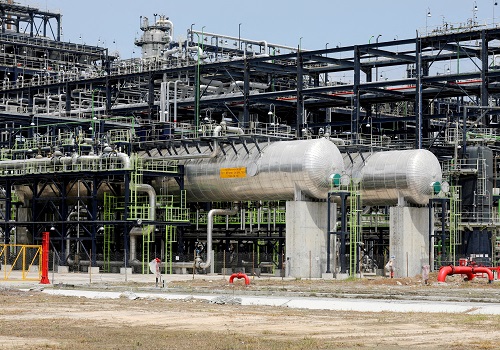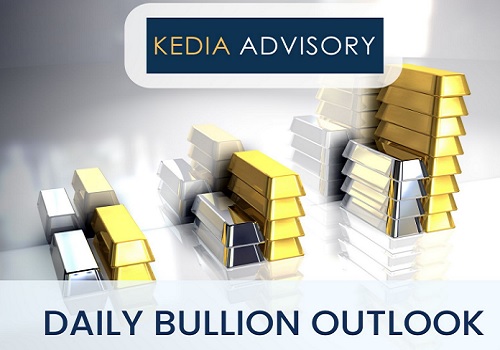Jeera trading range for the day is 28490-30570 - Kedia Advisory

Gold
Yesterday, gold prices rose by 0.85%, settling at 73,131, driven by labor market data that reinforced expectations of multiple interest rate cuts by the Federal Reserve this year. Initial unemployment claims unexpectedly surged to their second-highest level in 2023 during the last week of May, complementing weaker-than-expected ADP and JOLTs reports, which indicated a softening labor market. This data led investors to more confidently price in two rate cuts by the Fed. Meanwhile, both the European Central Bank (ECB) and the Bank of Canada (BoC) initiated rate cuts this week, signaling the beginning of their respective easing cycles. In China, gold imports via Hong Kong plummeted by 38% in April compared to March, according to the Hong Kong Census and Statistics Department. Net imports to China, the world’s largest gold consumer, amounted to 34.6 metric tons in April, down from 55.8 tons in March. This decline contrasts with the first quarter's strong consumption, which saw a 5.94% year-over-year increase, with 308.91 metric tons consumed by Chinese buyers. High prices have dampened retail demand for physical gold across most Asian markets. Indian dealers continued to offer discounts, reaching up to $9 an ounce over official domestic prices, down from $13 last week, as wedding season demand remained subdued. Technically, the gold market is under fresh buying pressure, with open interest increasing by 0.52% to settle at 16,873 contracts. Prices saw a gain of 613 rupees, with support now at 72,740 and potential testing of 72,355 levels if breached. Resistance is likely at 73,410, and a move above this level could see prices testing 73,695.
Trading Ideas:
* Gold trading range for the day is 72355-73695.
* Gold gains as labor market data supported bets Fed may cut interest rates more than once this year.
* Initial unemployment claims unexpectedly jumped to its second-highest level this year in the last week of May.
* Interest rate futures showed that investors have a clearer consensus in pricing two rate cuts by the Federal Reserve this year.
silver
Yesterday, silver prices surged by 3.73% to settle at 93,816 as investor sentiment shifted towards expecting the Federal Reserve to deliver its first rate cut in September. The increase in silver prices was fueled by signs of a softening job market in the US, which compounded the pressure on the dollar, alongside a more hawkish outlook for the ECB. Initial unemployment claims in the US unexpectedly soared, reaching their highest level since early May, which has strengthened the market's conviction that the Fed will implement two rate cuts this year. In parallel, the ECB and the Bank of Canada (BoC) initiated their rate cut cycles this week, which was largely anticipated by the markets. Additionally, the number of unemployment benefit claims rose by 8,000 to 229,000 for the week ending June 1st, exceeding market expectations and reflecting further signs of economic slowdown. In India, silver imports have surged significantly, with imports in the first four months of 2024 already surpassing the total for all of 2023. This increase is driven by rising demand from the solar panel industry and investor bets on silver's outperformance compared to gold. India imported a record 4,172 metric tons of silver from January to April, compared to 455 tons in the same period last year, with almost half of these imports coming from the UAE due to lower import duties. Technically, the silver market is experiencing fresh buying, with a 4.8% increase in open interest to 23,770 contracts. Silver prices, having risen by 3,372 rupees, now find support at 91,800, with a potential test of 89,790 if this level is breached. Resistance is expected at 94,860, and a move above this level could see prices testing 95,910.
Trading Ideas:
* Silver trading range for the day is 89790-95910.
* Silver rose as investors are increasingly convinced the Fed may deliver the first-rate cut in September.
* The US 10-year Treasury note yield was around 4.3%, holding close to two-month lows.
* Initial unemployment claims unexpectedly soared to their highest since the eight-month high in early May
crude oil
Yesterday, crude oil prices surged by 2.2%, settling at 63.26, driven by growing expectations of a September interest rate cut from the U.S. Federal Reserve. This optimism overshadowed concerns about higher U.S. inventories and OPEC+'s gradual plans to increase supply. OPEC Secretary General Haitham Al Ghais and Russian Deputy Prime Minister Alexander Novak defended the OPEC+ deal, expressing confidence in sustained oil demand. Al Ghais praised the recent revisions to the output agreement, highlighting a recovery in travel and robust oil demand. However, worries lingered about potential supply increases later in the year, despite sluggish demand growth. The U.S. Department of Energy announced the purchase of another 3 million barrels of oil for the Strategic Petroleum Reserve, aiming to gradually replenish it after the largest sale ever in 2022, at an average price of $77.69 per barrel for November delivery. In contrast, the EIA Petroleum Status Report revealed a surprise increase of 1.233 million barrels in U.S. crude oil stocks for the week ending May 31, 2024, contrary to market expectations of a 2.30 million barrels decline. Additionally, gasoline stocks surged by 2.102 million barrels, exceeding expectations, while distillate stockpiles soared by 3.197 million barrels, further surpassing consensus forecasts. Technically, the crude oil market experienced short covering, with a significant 33.32% drop in open interest, settling at 9,711 contracts, as prices rose by 136 rupees. Support is identified at 62.36, with a potential test of 61.46 if this level is breached. Resistance is anticipated at 63.74, and a move above could lead to testing of 64.22. Traders will closely monitor OPEC+ developments and economic indicators for market direction.
Trading Ideas:
* Crudeoil trading range for the day is 6146-6422.
* Crude oil gains as support from growing expectations of an interest rate cut from Fed in September.
* OPEC's head rejects criticism over oil deal, saying demand is good.
* US buys 3 million barrels of oil for Strategic Petroleum Reserve
Natural gas
Natural gas prices surged by 2.54% to settle at 234, driven by a recent drop in daily output and forecasts of hotter-than-normal weather later in June. The increase in demand is also supported by rising gas flow to LNG export facilities, particularly with the Freeport LNG plant in Texas back in operation. However, exports remain below the December 2023 record due to ongoing maintenance at several facilities. Gas output in the Lower 48 US states has slipped to an average of 98.0 billion cubic feet per day (bcfd) so far in June, down from 98.1 bcfd in May and significantly lower than the monthly record of 105.5 bcfd in December 2023. This decline in production is attributed to energy firms delaying well completions and cutting drilling activities earlier in the year when prices fell. Meteorologists project warmer-than-normal weather across the Lower 48 states through June 21, with gas demand expected to ease slightly from 93.7 bcfd this week to 93.1 bcfd next week. Meanwhile, US utilities added 98 billion cubic feet of gas into storage during the week ending May 31, exceeding market expectations and marking the ninth consecutive week of seasonal increases. Stockpiles now stand at 2,893 Bcf, significantly higher than last year and the five-year average. Technically, the natural gas market is experiencing fresh buying, with a 1.43% increase in open interest to settle at 15,042 contracts. Current support for natural gas is at 227.9, with a potential test of 221.7 if this level is breached. Resistance is likely to be encountered at 240.3, and a move above this could see prices testing 246.5.
Trading Ideas:
# Naturalgas trading range for the day is 221.7-246.5.
# Natural gas climbed on a recent drop in daily output and forecasts for hotter weather.
# Additionally, gas flow to LNG export facilities has been on the rise.
# US utilities added 98 billion cubic feet of gas into storage
Copper
Copper prices surged by 1.4% to settle at 881.8, bolstered by a softer U.S. dollar and signs of improved demand from China. The easing of the dollar was attributed to renewed expectations of a U.S. Federal Reserve easing cycle anticipated later in the year. Meanwhile, copper buyers in China resumed some activities that had slowed down due to a surge in prices last month. This positive sentiment was further supported by China's services activity in May, which accelerated at the quickest pace in 10 months, following robust growth in factory activity last month. Despite these positive indicators, copper inventories climbed to a six-week high of 118,950 tonnes in LME warehouses, with deliveries to registered warehouses in Taiwan. Shanghai's inventory also remained near 300,000 tonnes since March, suggesting that Chinese copper inventories have not yet begun their seasonal decline, indicating a more sufficient supply in the copper market than initially thought. Additionally, Indonesia announced a 7.5% export tax on shipments of copper concentrate, effective immediately, impacting two mining firms currently exempt from the ban on raw copper exports. In terms of global refined copper market dynamics, the International Copper Study Group (ICSG) reported a surplus of 125,000 metric tons in March, compared to 191,000 metric tons in February. From a technical standpoint, the copper market witnessed short covering, with a 0.96% drop in open interest to settle at 5,860 contracts. Currently, copper is supported at 875, with a potential test of 868.2 if this support level is breached. Resistance is expected at 885.8, and a move above this level could see prices testing 889.8.
Trading Ideas:
* Copper trading range for the day is 868.2-889.8.
* Copper gains buoyed by a softer U.S. dollar and signs of better demand China.
* The dollar eased on renewed bets of a U.S. Federal Reserve easing cycle expected this year.
* Copper buyers in China resumed some activities that had been dampened by a surge in prices last month.
Zinc
Zinc prices surged by 1.34% yesterday, settling at 261.8, bolstered by a weaker dollar and the anticipation of earlier U.S. rate cuts amid lackluster economic data. Soft economic indicators in the U.S. have strengthened the case for prompter rate reductions by the Federal Reserve, prompting a rebound in the dollar from its mid-March lows. In China, the official purchasing managers' index (PMI) slipped to 49.5 in May from April's 50.4, indicating a contraction in economic activity. Data from April 2024 revealed a decline in China's refined zinc output, down by 3.99% month-on-month and 6.56% year-on-year. However, domestic zinc alloy production saw a modest increase of 1,100 mt from the previous month. Smelter output was impacted by routine maintenance in various regions like Xinjiang, Yunnan, and Gansu, along with equipment and raw material issues in Henan, Shaanxi, Yunnan, and Hunan. Chinese authorities introduced significant support measures, including lowering the minimum mortgage interest rates for first-time and second-time buyers. Moreover, data from the International Lead and Zinc Study Group (ILZSG) showed a reduction in the global zinc market surplus to 52,300 metric tons in March, down from 66,800 tons in February. Despite this, the surplus for the first three months of the year was 144,000 tons, compared to 201,000 tons in the same period last year. Technically, the zinc market experienced short covering, with a 5.12% drop in open interest, settling at 3,135 contracts, while prices rose by 3.45 rupees. Support is identified at 259.6, with potential testing of 257.3 if breached. Resistance is expected at 263.2, and a move above this level could lead to testing of 264.5.
Trading Ideas:
* Zinc trading range for the day is 257.3-264.5.
* Zinc gains supported by a softer dollar and prospects of earlier U.S. rate cuts amid weak economic data.
* The global zinc market surplus fell to 52,300 metric tons in March from 66,800 tons in February – ILZSG.
* China's refined zinc output was 504,600 mt, a month-on-month decrease of 20,900 mt or 3.99%.
Aluminium
Aluminium prices surged by 1.07% to settle at 241.65 on the back of optimism surrounding potential central bank rate cuts and their anticipated positive impact on economic growth. However, gains were tempered by concerns about sluggish demand in the market. Shortages of alumina, a critical intermediary product in aluminium production, have emerged due to reduced output from China and disruptions to Rio Tinto's Australian exports. The mining giant's declaration of force majeure on alumina cargoes from its Australian refineries has raised concerns about the supply of this key material from the world's second-largest producer. Amidst these supply concerns, a global aluminium producer offered Japanese buyers a premium of $175 per metric ton for July-September, signaling confidence in the demand outlook. Despite supply disruptions, global primary aluminium output in April increased by 3.3% year-on-year to 5.898 million tonnes, according to data from the International Aluminium Institute (IAI). China's imports of unwrought aluminium and products surged by 72.1% year-on-year in April to 380,000 metric tons, with imports in the first four months of the year reaching 1.49 million tons, up by 86.6% from the same period last year. Additionally, Russian imports totaled 392,775 tons in the first quarter of the year, marking a significant increase of 127.7% compared to the corresponding period last year. From a technical standpoint, the aluminium market is experiencing fresh buying momentum, with a 1.69% increase in open interest to settle at 3,315 contracts. Currently, aluminium is supported at 240.1, with a potential test of 238.5 if this support level is breached. Resistance is expected at 243, and a move above this level could see prices testing 244.3.
Trading Ideas:
* Aluminium trading range for the day is 238.5-244.3.
* Aluminium prices rebounded on optimism that central bank rate cuts will help economic growth
* Gas shortages drove mining giant Rio Tinto to declare force majeure on alumina cargoes from its Australian refineries, raising concerns about supply.
* Shortages of alumina, emerged recently because of lower output from China and disruption to Rio Tinto's Australian exports.
Cotton candy
Cotton candy prices experienced a marginal decline of -0.11%, settling at 56,900, primarily driven by sluggish milling demand amid muted global yarn demand. Despite this, downward pressure was limited as India's cotton continued to attract strong demand from countries like Bangladesh and Vietnam. Additionally, there are expectations of a better crop in countries such as Australia, which could potentially impact supply dynamics. The International Cotton Advisory Committee (ICAC) has projected increases in cotton-producing areas, production, consumption, and trade for the next season, 2024-25. Furthermore, India's cotton stocks are anticipated to decline by nearly 31% in 2023/24, reaching their lowest level in over three decades due to lower production and rising consumption. This reduction in stockpiles is expected to limit exports from India, the world's second-largest producer, and support global cotton prices. However, it could also elevate domestic prices and weigh on the margins of local textile companies. Looking ahead, for marketing year 2024/25, India's cotton production is estimated to decrease slightly to 25.4 million 480 lb. bales due to farmers shifting acreage to higher return crops. Meanwhile, mill consumption is projected to increase by two percent, driven by improved demand for yarn and textiles in major international markets. Import duties on extra-long staple (ELS) cotton have been rescinded, leading to an estimated 20% increase in imports. From a technical standpoint, the cotton candy market witnessed fresh selling pressure, with a 0.55% increase in open interest to settle at 363 contracts. Support is currently seen at 56,680, with potential further downside to 56,460. Resistance is likely to be encountered at 57,060, with a potential move above leading to testing 57,220.
Trading Ideas:
* Cottoncandy trading range for the day is 56460-57220.
* Cotton dropped as sluggish milling demand is still concerns amid muted demand of yarn
* U.S. ending stocks projected 1.3 million bales above 2023/24 level
* Global supplies in 2024/25 projected to be higher than previous year
* In Rajkot, a major spot market, the price ended at 26902.3 Rupees gained by 0.1 percent.
Turmeric
Turmeric prices edged up by 0.5% to settle at 17330 as farmers held back stocks anticipating further price rises. However, this upward momentum was tempered by increased supplies towards the end of the harvesting season. The prevailing heatwave across India poses a threat to crop yields, potentially exacerbating supply constraints and supporting prices. The India Meteorological Department forecasts continued hot weather across most parts of the country, with below-normal rainfall exacerbating the situation, particularly in southern regions. Despite the potential for higher prices, there are concerns of demand destruction as prices surged, leading many to adopt a hand-to-mouth approach. However, regions like Sangli, Basmat, and Hingoli, known for turmeric cultivation, are experiencing robust demand for quality produce, driven by expectations of increased sowing areas this year. Export data reveals a 4.75% decline in turmeric exports during Apr-Mar 2024 compared to the previous year, while imports dropped by 12.71% during the same period. However, in March 2024, turmeric exports witnessed a notable increase compared to February, although they remained lower than the same period last year. Technically, the market experienced short covering, with a decrease in open interest by -7.47% alongside a price increase of 86 rupees. Support levels for turmeric are identified at 17138, with a potential test of 16944 if this level is breached. Resistance is anticipated at 17464, with a move above indicating a potential testing of 17596. In the major spot market of Nizamabad, turmeric prices ended at 17965.2 Rupees, registering a slight decline of -0.08 percent. Overall, while short-term price movements reflect a balance between supply constraints and demand dynamics, the prevailing weather conditions and production estimates will likely influence market sentiment in the coming months.
Trading Ideas:
* Turmeric trading range for the day is 16944-17596.
* Turmeric prices gained as farmers are holding back stocks in anticipation of a further rise.
* The current heat wave could severely damage the crop yield, further contributing to the supply crunch.
* The Ministry of Agriculture first advance estimate for turmeric production in 2023-24 is estimated at 10.74 lakh tonnes
* In Nizamabad, a major spot market, the price ended at 17965.2 Rupees dropped by -0.08 percent.
Jeera
Jeera prices surged by 1.61% to settle at 29610 amidst robust domestic and export demand coupled with tight global supplies. The withholding of stocks by farmers in anticipation of better prices further supported the upward momentum. However, the upside potential is limited due to expectations of higher production, which could exert downward pressure on prices. Projections indicate a 30% increase in jeera production this season, driven by a substantial rise in cultivation area, particularly in Gujarat and Rajasthan. Globally, cumin output has witnessed significant growth, with China leading the surge, contributing to the tightening of global supplies. Despite high prices in the previous season, increased production is anticipated in countries like Syria, Turkey, and Afghanistan. This influx of new supplies, coupled with reduced export trade, is expected to weigh on prices, especially at higher levels. The increase in production is evident in the rise of sowing areas in key cumin-producing regions of India, such as Gujarat and Rajasthan, resulting in record-high production levels. This surge in production is expected to boost exports, with trade analysts estimating a substantial increase in cumin exports, potentially reaching 14-15 thousand tonnes by February 2024. However, export data for Apr-Mar 2024 indicates a 13.53% decline compared to the previous year, highlighting the challenges posed by fluctuating domestic prices. Technically, the market experienced short covering, with a decrease in open interest by -2.58% alongside a price increase of 470 rupees. Support levels for jeera are identified at 29060, with a potential test of 28490 if breached, while resistance is expected at 30100, with a potential move above indicating testing of 30570.
Trading Ideas:
* Jeera trading range for the day is 28490-30570.
* Jeera gained amid robust domestic and export demand besides tight global supplies.
* China's cumin output soared to over 55-60 thousand tons from the previous 28-30 thousand tons.
* Turkey anticipates producing 12-15 thousand tons, while Afghanistan's output could double.
* In Unjha, a major spot market, the price ended at 29077.45 Rupees dropped by -0.04 percent.
Views express by all participants are for information & academic purpose only. Kindly read disclaimer before referring below views.









Top News

Manufacturing drives India`s flash PMI to 60.7 in July, private sector shows robust growth











